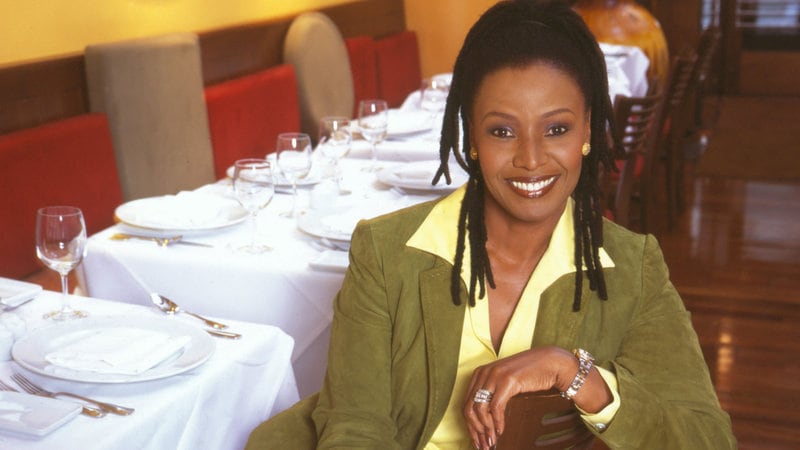Model-turned-restaurateur Barbara Elaine Smith, or B. Smith, was at the top of my list of together sisters.
She truly lived up to the title of one of her books: B. Smith’s Entertaining and Cooking for Friends. At her restaurants, she made strangers feel like friends and friends feel like family. And all of us are saddened today to hear that she has made her transition at the age of 70.
We met when I was in my late 20s. I was working at The New York Times, around the corner from her first restaurant, B. Smith’s, which she opened in 1986. It instantly became my restaurant of choice.
The same was true at her Washington location when I moved to the nation’s capital. It was always great to see Barbara when she was in town. She smiled when I shared that her jerk turkey recipe was a hit at Thanksgiving. But one visit was markedly different from all the others. Looking amazing in a studded denim pantsuit, she was startled when I greeted her. Barbara’s eyes grew wide, and her 100-watt smile dimmed. My heart sank.
I had known Barbara for nearly three decades at that point — long enough to know that she wasn’t being “brand new.” Something was amiss, and I couldn’t quite put my finger on it or didn’t want to deep, down inside.
Before long, we all learned that Barbara had been diagnosed with early-onset Alzheimer’s. It was like a kick to the gut, but it explained the startled look on her face. It was the same look that my mother gave family and friends whom she could no longer recognize by name and/or face. Like Barbara, my mother also had a form of dementia.
Barbara’s diagnosis and now her death have shaken many admirers to their core.

Even if you didn’t know that Barbara reigned as one of the world’s top models, you’d wonder, because she always looked the part with a style all her own. To call her the “black Martha Stewart” is a misnomer. If anything, she was Black Girl Magic long before anyone had coined the term.
Not only was Barbara the epitome of class and grace, but she also inspired us with her power as we watched the B. Smith empire unfold. In addition to her series of lifestyle books, Barbara hosted the “B. Smith With Style” syndicated television series and a few specials, launched the B. Smith With Style Home Collection, published B. Smith Style magazine just ahead of O, the Oprah Magazine, and expanded her restaurants beyond Manhattan and Washington to Sag Harbor, New York.
Her flagship in the heart of Times Square at 47th Street and Eighth Avenue quickly became a center of culture and community. The elegant décor accented with stunning floral arrangements made dining and social events special, by B. Smith design.
It was also the spot for twenty and thirtysomethings who wanted to see and be seen through the glass-enclosed bar area. While the optics didn’t matter to me, I hung out there, too, enjoying cocktails and conversation with my girls or a date.
The dishes were delectable — more cosmopolitan in New York; more southern in D.C., offering “classy, exquisite soul food,” as a friend put it, with an emphasis on fresh vegetables, herbs and spices. Besides the salmon and crab cakes, my favorite dish was the miniature sweet potato pie with praline pecan sauce and a crust accented with nutmeg, cinnamon and cloves. But what I enjoyed most was chatting with Barbara. She stopped by everyone’s table, but she’d sit a spell when she had time.
We both grew up in the Rust Belt; I was born in Akron, Ohio, and she was from Everson and Scottdale, Pennsylvania, both southeast of Pittsburgh. I learned about the culinary skills she inherited from her mother, grandmother and aunts, along with her entrepreneurial spirit. She explained how beneficial it was to have spent time on the floor and behind the scenes at her business partner’s restaurant before opening her own.
Barbara always made sure that I had a good table, especially if my mother was visiting from Ohio, but there was no such thing as a bad table at B. Smith’s. She was encouraging personally and professionally, as she planted seeds about entrepreneurship. She always asked about my projects and offered a photo from her first marriage, when I mentioned that I was writing a freelance piece about island weddings. I had a memorable wedding in St. Croix in the U.S. Virgin Islands, but hers was on Mustique. Years later on a sailing trip, I saw firsthand why she chose that part of paradise in St. Vincent and the Grenadines.
When I was raising funds to endow a scholarship at Columbia University to honor a friend who had died of cancer at the age of 28, Barbara lowered her fees so that the New York Association of Black Journalists could host a cast party with August Wilson and actors from his Broadway play. I never got to see her own run off-Broadway in “Love, Loss and What I Wore” by Nora and Delia Ephron. But I heard Barbara sing at B. Smith’s, wondering “Is there anything that she can’t do?”
In true fashion, Barbara became an advocate for Alzheimer’s research and treatment for as long as her memory allowed. Alzheimer’s is the most common form of dementia, accounting for up to 80 percent of cases. It affects more than 5 million Americans, with about 200,000, or 5 percent, suffering from early onset before the age of 65 and as young as their 30s, according to the Alzheimer’s Association. Barbara began showing signs of early-onset Alzheimer’s in 2008 during her late 50s and was diagnosed in 2013.
“The estimated lifetime risk for Alzheimer’s dementia at age 45 was approximately one in five (20 percent) for women and one in 10 (10 percent) for men,” according to data from the Framingham Heart Study.
Overall, nearly two-thirds of Americans who have Alzheimer’s are women, and African Americans are twice as likely as whites to develop the disease, according to the Alzheimer’s Association.
As someone who was dealing with dementia up close, I was pleased to see Barbara take on this important cause. She also co-authored a self-help book with her husband, Dan Gasby, Before I Forget: Love, Hope, Help and Acceptance in Our Fight Against Alzheimer’s.
Like many people, however, I felt some kind of way in 2018 when it became public that Dan’s girlfriend was Barbara’s caregiver and lived in their home on occasion. Many sisters were also outraged that the caregiver was a white woman. I didn’t care if she was purple. I thought it was disrespectful then, and I still do.
While every case of dementia is different, I’ve seen enough moments of lucidity among my mother and others to believe that an outside relationship in their environment could be hurtful and harmful. I pray that Barbara never had an inkling.
Barbara believed in paying it forward. She championed more support for Alzheimer’s research, treatment and eventually a cure. She also pushed education. This includes seeking medical advice if you or your loved ones notice early signs of dementia. It also means discussing preferences for medical care with loved ones, making arrangements for caregiving and preparing living wills. (See “Alzheimer’s Action Plan,” below.)
The thornier issue is whether longer life spans should have any impact on honoring marriage vows “in sickness and in health, to love and to cherish, till death us do part, according to God’s holy law.”
People with Alzheimer’s can live up to two decades after diagnosis, but it’s typically four to eight years — seven in Barbara’s case. While I know that some people leave or start new relationships when their mates have long-term illnesses, I believe in going the distance — with or without vows.
What I know for sure is that Heaven just gained one of its most stylish angels. And we’re all the better for her legacy of entrepreneurial excellence with class and grace.
Yanick Rice Lamb, who teaches journalism at Howard University, is co-founder of FierceforBlackWomen.com.
Alzheimer’s Action Plan
If you or a loved one has been diagnosed with Alzheimer’s or another dementia, you are not alone. The Alzheimer’s Association offers information, education, referral and support to millions of people affected by the disease. For details, click on the keywords below:
- Call a 24/7 Helpline: 800-272-3900
- Locate your local Alzheimer’s Association
- Use the Alzheimer’s Association Virtual Library
- Go to Alzheimer’s Navigator to create customized action plans, and connect with local support services
- Check out 10 Early Signs and Symptoms of Alzheimer’s
- Read “African Americans and Alzheimer’s Disease: The Silent Epidemic”
Also see “Dealing With Dementia: Caring for My Mother” — a touching story of love and loss that is becoming more and more common as increasing numbers of African Americans develop Alzheimer’s and other forms of dementia.








